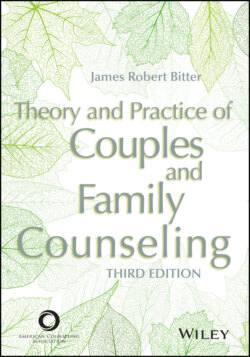Читать книгу Theory and Practice of Couples and Family Counseling - James Robert Bitter - Страница 100
A Participatory Ethics Model
ОглавлениеWhat might a model of ethical decision-making based on participatory ethics look like? The specific process we propose here is based on the model of feminist ethical decision-making constructed by Rave and Larsen (1995) and the model for the vulnerable therapist described by Coale (1998). Participatory ethics retains much of the structure of a rational-evaluative process and still requires the self-reflection of a feeling-intuitive process. But instead of leaving ethical decisions completely in the hands of the family practitioner, participatory ethics focuses on the relational, coconstructed knowledge that comes from active involvement of clients in the decision-making process. The model may be applied as follows:
1 Recognizing a problem. Problem recognition comes from a combination of perspectives. The family practitioner’s personal and professional knowledge, competence, and gut feelings are combined with the clients’ local knowledge and gut feelings in an effort to understand and clarify the ethical dilemma. The family practitioner’s task is to open space within the counseling or therapy sessions for the clients to inform the ethical process. They open space by actively encouraging input, feedback, and the sharing of client perspectives on the counseling process.
2 Defining the problem. Once the counselor and the clients come to an understanding of the ethical dilemma that is present, each party contributes to a conversation about how to define and frame the problem. All of the questions posed by the virtue ethics model related to stakeholders and feelings are relevant here. What extends the virtue ethics model is the inclusion of the clients in defining the problem as well as understanding the cultural values that the family practitioner brings to the process. From a postmodern perspective, the cultural selves of family practitioners are not simply acknowledged and managed but are embraced and brought into conversations with the clients. In this way, the emphasis is on situating the counselor’s selves as cultural beings within the decision-making process, highlighting, not hiding, such influences. The family practitioner trusts the family to handle the very human, ethical struggle in which the practitioner and all other parties are engaged.
3 Developing solutions. This step of the participatory ethics model is very similar to Steps 5 and 6 of the virtue ethics model. Again, the defining element of the participatory model is valuing clients’ conceptualizations of solutions and their reaction to each possibility. Consultation is integral to the process of developing solutions and may involve inviting still other voices into collaborative conversations with clients.Even though we are presenting the participatory ethics model in linear steps, in this model, like most approaches to family systems, the steps are recursive—with each step influencing and being influenced by the others. Furthermore, it is not uncommon for each additional step to require adjustments and reconsiderations in earlier steps. All of this is especially true when consultation is being integrated into the process. Engaging in consultation may require circling back to previous conversations, and consultation may be integrated throughout the rest of the process. In participatory ethics, no single step can be a one-time occurrence in the process of ethical decision-making.
4 Choosing a solution. Just as the virtue ethics model values self-reflection at both the rational and emotional levels, participatory ethics values conversations with clients about their processes and reactions, rationally and emotionally, to possible solutions. Respect for self-agency is central to the dialogue, and the goal is to select a solution that all parties, including the family practitioner, can support.
5 Reviewing the process. This step starts with the family practitioner openly reflecting on all aspects of the ethical decision-making process in which the counselor is engaged:Would the family practitioner want to be treated this way?How are the values and personal characteristics of the family practitioner influencing the choices that have been made?What has been the effect of the family practitioner’s power in these ethical conversations?Have the clients’ perspectives been taken into account? (Rave & Larsen, 1995).Opening oneself to deliberate reflection may serve to check the credibility and trustworthiness of the constructed solution. It also models for clients the importance of self-reflection in this participatory process.
6 Implementing and evaluating the decision. Participatory ethics recognizes that ethical dilemmas force everyone into a state of vulnerability and sometimes anxiety (Coale, 1998). It is a model in which all parties participate in both the decision-making and the consequences of the decisions made. The process cannot end with the implementation of a decision: Evaluation and regular reevaluation are essential:Does the outcome continue to feel right?How has the decision affected the therapeutic process?Is the solution we chose the best we can do?
7 Continuing to reflect. The last step in the participatory ethics model returns the family practitioner to self-reflection and a consideration of the ethical decision-making process in a removed or disengaged space:What did I learn from the process about myself and about the participatory process?How might this experience affect me in the future?How, if at all, have I changed as a result of my participation in the process?The practitioner must not only examine the outcome for the client but also reflect on the decision’s impact in relation to themselves. Each and every decision made extends into the future, well beyond the current clients’ situation. Valuing personal and professional experiences of the process through continued reflection facilitates greater awareness and learning for the family practitioner and enhances the ethical process with future clients.
We have presented only three models of ethical decision-making here. What reactions do you have to each of them? What feelings surface? Your thoughts and feelings speak to the kind of person you want to be as a family practitioner.
